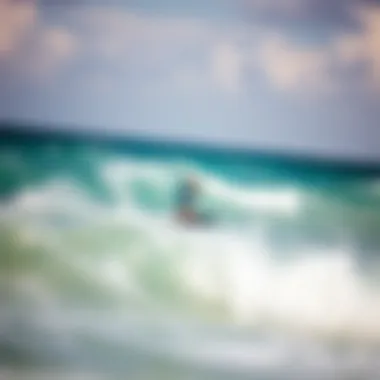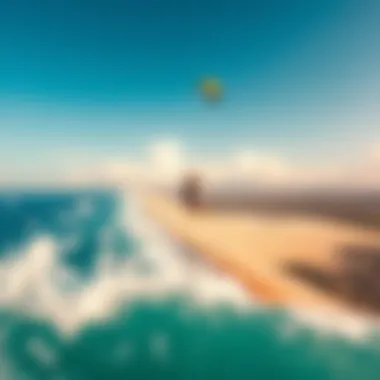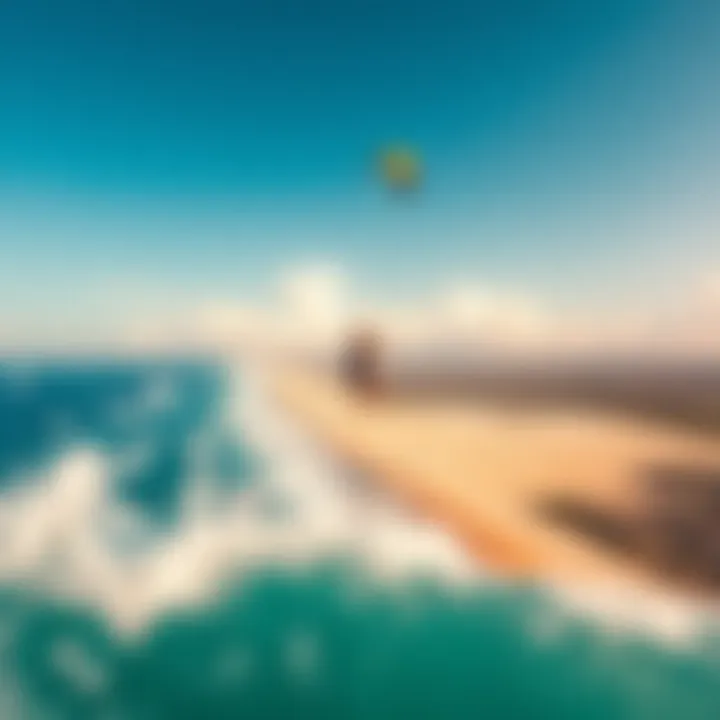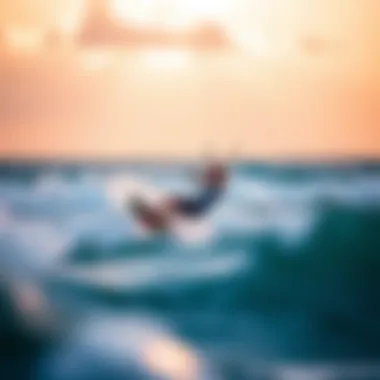Kitesurfing in Mexico: Top Spots and Essential Skills


Intro
Kitesurfing in Mexico serves as an irresistible invitation to wind enthusiasts and water sports lovers alike. Boasting stunning coastlines—from the azure waters of the Caribbean to the breezy shores of the Pacific—Mexico provides an array of ideal conditions for both novice and experienced kiteboarders. The diverse geographical features create unique wind patterns, drawing kitesurfers to popular destinations like Tulum, La Ventana, and Cabarete.
This article aims to delve deep into the heart of kitesurfing in Mexico. It covers not only the best locations but also essential techniques and equipment that cater to varying skill levels. With a focus on ensuring safety and embracing local culture, it becomes apparent that kitesurfing isn't just a sport here; it's a way of connecting with nature and the community.
As we embark on this journey, we’ll highlight key aspects that every kiteboarder must know to ride the winds of Mexico with confidence.
Techniques for Kiteboarding Enthusiasts
Kiteboarding, much like any other sport, has its own set of techniques that can either make or break your experience on the water. Understanding these techniques can help in harnessing the wind effectively while maintaining control—two essential components for an enjoyable ride.
Beginner Techniques
For those just starting out, mastering the basics is paramount. Here are several techniques to get yourself up and riding:
- Understanding Wind Direction: Knowing where the wind is coming from is crucial. It can influence your kite's positioning and your speed.
- Kite Control: Practicing how to steer and control the kite while standing on the board is important. Start with your feet on the board and hands on the bar, gradually learning to balance.
- Launch and Land Safely: Always have a partner; one person should help while the other controls the kite. This avoids accidents and ensures everything goes smoothly.
- Water Starts: When you're ready, begin by sitting in the water, holding the kite at the right angle. Let the kite pull you gently onto your feet, creating an exhilarating feeling.
Advanced Maneuvers
Once you've conquered the basics, it’s time to elevate your skills. Here are a few advanced techniques that seasoned kitesurfers should consider:
- Jumping: Learning how to jump can take your kitesurfing to the next level. Approach with speed and use the kite’s power to lift off the water.
- Transitions: Skills to switch direction while maintaining speed are fundamental. Practice bending your knees and turning your body for seamless transitions.
"To learn to ride the wind is to embrace freedom itself."
- Tricks and Stunts: As you gain confidence, consider trying tricks like the Back Loop or the Kite Loop to impress fellow riders.
Each of these techniques contributes significantly to becoming proficient in kitesurfing. By practicing these methods, riders can not only enhance their skills but also enjoy the exhilarating sensation that comes with conquering the waves.
Closure of Techniques
Whether you're just starting or looking to polish your advanced skills, remembering to practice consistently is vital. Consider joining local communities or forums like Reddit to connect with fellow kiteboarders, share techniques, and even find potential riding buddies. As we transition into equipment reviews, understanding what gear complements these techniques will help in your journey to mastering kitesurfing in Mexico.
Prologue to Kitesurfing in Mexico
Kitesurfing is not just a sport; it's a lifestyle, especially in Mexico, where the sun, wind, and waves come together in splendid harmony. The allure of gliding across turquoise waters, propelled by the wind, beckons both seasoned riders and those just dipping their toes into this exciting world. Understanding the intricacies of kitesurfing in Mexico goes beyond just the action; it's about immersing yourself in the vibrant local scenery, culture, and community that surrounds the sport.
Mexico's geographical variety plays a crucial role in making it an ideal playground for kitesurfers. From the gusty shores of Cancún to the serene waters of Isla Blanca, each location boasts unique wind conditions and landscapes. Additionally, the local culture enriches the experience, offering an atmosphere of warmth and hospitality.
Why is this important?
Exploring kitesurfing in Mexico is not merely about riding waves; it encompasses understanding the ideal conditions, the necessary gear, and the local etiquette, which is paramount for a safe and enjoyable experience. Diving into the local community can provide valuable insights and friendship that enhances one’s kitesurfing journey.
Kitesurfing also serves as a linchpin for local economies, stimulating tourism and supporting local businesses, such as schools and rental shops. Engaging with local instructors or fellow kiteboarders can provide a wealth of knowledge, improving skills and safety awareness.
In this article, we will traverse the best locations, delve into the essential techniques, and equip you with the know-how to navigate the local kitesurfing scene. Readers will uncover not just the thrill of kitesurfing itself, but also the cultural richness and communal spirit that makes it a rewarding pursuit in Mexico.
As we embark on this journey, let’s commit to understanding how to not only ride the wind but also to respect the places and people that make kitesurfing in Mexico a unique experience.
Geographical Overview
Understanding the geographical landscape of Mexico is crucial for kitesurfers. This country offers an array of coastlines, each presenting unique opportunities and challenges for riders. In regions where oceans meet the land, such as the invigorating beaches of the Caribbean and the expansive Pacific coast, kitesurfers can expect to find distinct wind patterns and water conditions that can enhance their skills and experience.
Diverse Coastlines
Mexico's coastlines are as varied as they are breathtaking. From the turquoise waters of Cancún to the rugged cliffs of Baja California, each spot provides different experiences. The climate and geographical diversity make it an ideal playground for kitesurfing.
- Caribbean Coast: Renowned for its consistent winds, locations like Isla Blanca and Cancún present flat, shallow waters ideal for beginners and advanced kitesurfers alike. The steady breeze here is often combined with warm weather, making it a paradise for year-round kitesurfing.
- Pacific Coast: This coast has a different character. The waves can be larger and more challenging, appealing to experienced riders looking for thrills. Places like La Ventana are known for their breathtaking sunsets and robust winds, perfect for those wanting to hone their skills in a more demanding environment.
The diversity in water conditions invites kitesurfers of every level, adding to the allure of Mexico as a kitesurfing destination. The coastal features set the stage for an exhilarating water sport experience, where every session might feel like a new adventure.


Key Wind Patterns
Wind patterns are a game-changer in kitesurfing. Understanding when and where to catch the best winds can significantly impact a kitesurfer's experience. In Mexico, the wind is influenced by many factors, including geography, seasons, and local weather patterns.
- Trade Winds: A major contributor to the wind patterns in Mexico are the trade winds, which typically blow from east to west across the Caribbean. These winds are steady, providing ample opportunities for kitesurfing, especially in coastal towns like Cancún. The consistent patterns can be predictable, allowing riders to plan their outings with relative ease.
- Seasonal Variations: During the winter months, places like La Ventana see an uptick in wind strength, appealing to more experienced kitesurfers looking for a challenge. The summer months generally bring lighter winds, which may be more suitable for beginners trying to master their techniques.
"In kitesurfing, understanding the wind is as essential as mastering the board. In Mexico, you will learn how to ride the winds like a local."
Mapping the wind patterns can ensure every session is optimally timed. Both geographic features and climatic influences play a vital role in determining wind conditions, allowing for personalized kitesurfing experiences based on skill levels and preferences. For anyone looking to truly maximize their time on the water in Mexico, grasping these elements is fundamental to success.
Best Kitesurfing Locations
Identifying the best kitesurfing locations in Mexico is paramount for anyone looking to either get started or elevate their skills in this exhilarating sport. These locations are not just random spots along the coast; they are precisely chosen for their unique wind patterns, safety considerations, and community support. Each destination boasts its own character and offerings, ensuring every kitesurfer finds the perfect ride. The beauty of kitesurfing in Mexico lies not just in the sheer thrill of the sport but also in the incredible environments in which it happens. You’ll get to witness dazzling sunsets, stunning ocean views, and vibrant local culture, all while honing your craft. Let’s explore these remarkable locations that cater to all experience levels.
Cancún - The Windy Paradise
Cancún is often the first name that springs to mind when we talk about kitesurfing in Mexico. Known as a bustling tourist hub, it boasts excellent conditions for kitesurfers of all levels. The winds are generally reliable, and the shallow waters make for a safe environment. One of the standout features here is the proximity to the Nichupté Lagoon, a large body of water where beginners can learn without the volume and chaos of the open sea.
This area also offers a plethora of instructors, making it easy for newcomers to pick up essential skills. Plus, the vibrant nightlife and resort amenities add to the allure after a day of riding the winds.
La Ventana - The Hidden Gem
In contrast to Cancún's bustling vibe, La Ventana is a more laid-back, serene option known for its unspoiled beaches and consistent winds. Situated in the Baja California region, it feels like a hidden treasure for kitesurfers. The wind here typically blows from November to April, and the spot attracts a more adventurous crowd. Riders looking for a quieter experience will appreciate the less commercialized nature of this locale.
There’s a strong community here, and it’s common to find gatherings where kitesurfers swap tips and stories. Local shops also offer high-quality rentals and repairs, making this the kind of location where everyone feels welcome.
Isla Blanca - Uncrowded Waters
Isla Blanca is often overshadowed by its more popular counterparts, but that’s all part of its charm. Located near Cancún, it offers vast stretches of open water with minimal crowds. The wate is flat, a perfect pitstop for novice riders wanting to practice their form.
What sets Isla Blanca apart is the peaceful atmosphere. Here, you can focus solely on honing your skills while soaking in stunning views of the Caribbean Sea. The direct access to the water simplifies logistics for those who come with their gear, and local vendors often set up nearby to offer refreshments and kite maintenance supplies.
Maui of Mexico - San Carlos
Known as the “Maui of Mexico,” San Carlos provides a unique blend of beautiful scenery and excellent wind conditions. Located along the Sea of Cortez, it’s lauded for its warm waters and striking mountain views. This place has an established kitesurfing community. The ideal conditions are typically found from April through October.
What really captures the essence of San Carlos is its diverse landscape. With plenty of spots to explore, whether you’re looking for wave riding or flat water, there is something for everyone. The recent increase in eco-friendly initiatives in the area also indicates a commitment to preserving its natural beauty for future generations.
Punta Chivato - Off the Beaten Path
For the adventurous spirit, Punta Chivato offers a captivating blend of solitude and thrill. This remote spot lies along the Baja coast, far from the bustling tourist areas. Here, riders can enjoy beautiful sunsets without the distraction of crowded beaches.
The wind conditions can be variable, but that adds to the challenge for experienced kitesurfers. This is the kind of place where you can truly immerse yourself in nature. For those seeking relaxation after a day on the water, the peaceful surroundings provide a perfect escape from the hustle and bustle of everyday life.
"Kitesurfing is not just about riding the waves; it's a lifestyle that connects you with nature."
Exploring best kitesurfing locations in Mexico goes beyond just finding ideal wind and water conditions. It's about experiencing the unique culture those spots offer. Whether you are drawn to the electric energy of Cancún or seek solace in Punta Chivato, each destination pairs kitesurfing with breathtaking scenery and community spirit, making your kitesurfing adventure truly one of a kind. For more insights and community involvement, check out resources like Kitesurfing Association or local forums on Reddit.
Best Time to Kitesurf in Mexico
Kitesurfing in Mexico offers an exhilarating experience, but timing is everything. Understanding the best time to kitesurf can elevate a good day on the water to an unforgettable one. This section delves into key elements that influence kitesurfing conditions, guiding both newcomers and seasoned enthusiasts in planning their adventures on the Mexican coast.
Seasonal Wind Conditions
Kitesurfing largely hinges on wind, and in Mexico, the seasonal patterns present a unique opportunity for riders. Generally, the prime months for kitesurfing stretch from December through April. During this window, steady winds whip across locations like La Ventana and Isla Blanca, making these spots coveted among kiteboarders.
The average wind speeds hover around 15 to 25 knots, which suits both beginners and those looking for a thrill. Kitesurfers can count on the northeasterly winds that prevail during the winter months. This is particularly pertinent for places like Cancún, where the conditions provide a reliable playground for enthusiasts.
Key Observations:
- December to April offers consistent wind patterns, especially in the Baja California region.
- Meridian winds commonly reach their peak during February and March, which are often considered the golden months for kitesurfing.
- Local knowledge suggests checking forecasts closely as wind patterns may fluctuate as the season progresses; keeping your eyes peeled for local weather reports pays off.


Ideal Weather Patterns
Weather runs hand-in-hand with wind in kitesurfing and can greatly enhance the overall experience. Ideal kitesurfing weather generally features warm temperatures, clear skies, and minimal precipitation. Mexico's kitesurfing season brings not only great wind but also the sun’s warm embrace.
From December to April, air temperatures are generally balmy, ranging from 70°F to 85°F during the day. This makes for a comfortable outing whether you're navigating the waters or waiting for the next breeze.
The tranquil waters at locations such as Punta Chivato also lend themselves to calmer conditions in the early mornings, which can be ideal for learning or practicing tricks in a less crowded environment.
Tips for Planning Your Kitesurfing Adventure:
- Consider longer trips during the peak wind season; the odds of hitting the sweet spot increase.
- Early mornings are generally less windy but great for enjoying quieter waters; afternoon breezes can churn up excitement.
- Keeping an eye on temperature fluctuations is also wise; as April approaches, expect warmer conditions which might necessitate lighter gear.
Remember to check local resources like Windguru for real-time updates on wind and weather forecasts. Planning conservatively ensures you'll make the most of your time on the waves.
Each of these aspects underscores the relationship between wind and water, informing the kitesurfing experience. For kitesurfers of all skill levels, understanding these seasonal elements can pave the way for optimal performance and enjoyment in the beautiful and diverse settings that Mexico offers.
Necessary Equipment for Kitesurfing
When it comes to kitesurfing, having the right equipment is not just a matter of convenience; it’s essential for your safety and performance on the water. The thrill of controlling a kite while speeding over waves can only be fully enjoyed when you are well-prepared. Each piece of gear plays a pivotal role in ensuring a smooth experience, and understanding these elements can make all the difference.
Choosing the Right Kite
Selecting the right kite is one of the most critical decisions a kitesurfer will face. Kites come in various shapes, sizes, and designs, which cater to different wind conditions and skill levels.
- Size Matters: The size of the kite typically ranges from about 5 meters to around 17 meters, and choosing the correct size depends on several factors:
- Types of Kites: There are generally two types of kites: the C-kite and the bow kite.
- Wind Conditions: In light winds, larger kites are more effective, while smaller kites are better suited for strong winds.
- Weight of the Rider: Heavier riders generally need larger kites to generate enough lift and power.
- C-kites are known for their performance and freestyle capabilities but can be harder to handle for beginners.
- Bow kites are more forgiving, providing better stability and lift but might lack the speed that some more experienced riders crave.
Choosing a kite that matches your skill level and riding style ensures not just enjoyment but provides better control over your run. It's akin to having the right tools in your workshop; you wouldn’t use a hammer when a screwdriver is needed.
Boards and Harnesses Explained
The board and harness are just as essential in your kitesurfing setup. A mismatched set can lead to frustration at best, or danger at worst.
- Board Types: Kitesurfing boards are generally categorized into two main types—directional and twin-tip boards.
- Harness Options: The harness is what connects you to the kite and offers support while riding. Two common types are:
- Directional boards are designed for riding in one direction, often preferred by surfers who want a surf-like experience.
- Twin-tip boards are more versatile, allowing riders to go in either direction and making tricks easier to execute.
- Chicken loop harness: Recommended for beginners since they provide more freedom of movement.
- Waist harness: More common among advanced riders due to better support for bigger jumps and tricks.
Your choice of board and harness impacts comfort and control. A board that fits well with your skill and preferences can enhance your performance significantly, just as the right harness distributes pressure evenly across your body for prolonged comfort.
Safety Gear Essentials
Kitesurfing does come with its own set of risks, thus safety gear is non-negotiable. This gear can save your life, literally. Here’s an overview:
- Impact Vest: An impact vest offers extra protection during falls, especially in shallow waters or when trying new tricks.
- Helmet: A well-fitted helmet can prevent head injuries from sudden falls or collisions.
- Leashes: A leash ensures that your kite doesn’t drift away in case of a crash; the last thing you want is to swim after a runaway kite!
- Floatation Device: Some riders opt for a buoyancy vest that helps keep them afloat in emergencies.
Keeping this safety gear handy allows you to focus more on enjoying kitesurfing without the looming worry of potential injury. As in all sports, it’s better to be safe than sorry.
Kitesurfing Techniques
Kitesurfing is more than just a pastime; it is an intricate dance of balance, skill, and respect for the elements. Mastering kitesurfing techniques can open a world of adventure, enabling riders to harness the wind’s power while gracefully gliding over water. Understanding these techniques is vital not only for delivering the exhilarating thrill of the sport but also for ensuring safety and control. Every kiteboarder, whether a novice or a seasoned pro, must navigate through the essential skills and advanced maneuvers that define kitesurfing.
Fundamental Skills for Beginners
Starting out in kitesurfing can often feel like trying to learn how to juggle knives while riding a unicycle, but with the right foundational skills, it can become a fun and rewarding journey. Here are some fundamental skills that every beginner must focus on to begin their kitesurfing adventure:
- Kite Control: This is paramount for safety and enjoyment. Understanding how to control the kite in various wind conditions is the bedrock upon which all else is built. Beginners should practice flying a trainer kite on land first to develop a feel for how wind interacts with the kite.
- Body Dragging: This technique is essential as it helps beginners learn how to manage their position in the water while still being attached to the kite. Working on body dragging—without the board—helps build confidence as you get to feel the kite pulling you along.
- Water Starts: Once comfortable with body dragging, the next step is mastering water starts. This involves getting up on the board from the water while maintaining kite control. The key is to position the kite at the right angle and pull with enough speed.
- Riding Technique: It's all about posture. Beginners should focus on keeping their knees slightly bent, leaning back, and finding that sweet spot of balance. Just like riding a bike, a lot of it will come down to muscle memory.


Taking the time to master these skills is essential. Skipping steps can lead to bad habits, which can be both frustrating and dangerous.
Advanced Techniques for Experienced Riders
Once you've got the basic skills under your belt, it’s time to up the ante. Advanced kitesurfing techniques not only expand your repertoire but also allow you to enjoy the sport at a deeper level. Explorations into jumps, tricks, and refined style set the experienced rider apart:
- Jumping: The transition from mere riding to jumping is exhilarating. A good jump starts with proper approach speed and the right kite position. The goal is to go up and not just out. Riders should focus on using their legs to pop off the water, while the kite should be pulled higher to gain elevation.
- Tricks and Maneuvers: Tricks such as 'handle passes', 'kite loops', and 'backrolls' add flair to your riding. These require significant kite control and timing. It’s crucial to practice these in safe conditions, preferably with an experienced buddy or instructor.
- Wave Riding: For those who enjoy an additional challenge, wave riding offers a unique blend of maneuvering skills both on the board and with the kite. Catching a wave demands not only skill but a keen understanding of the ocean’s rhythm.
- Advanced Kite Techniques: Mastering the art of controlling the kite in different wind conditions and experimenting with different kite sizes can unlock new riding experiences. This means knowing when to switch from a big kite for light wind to a smaller kite when it’s howling.
These advanced techniques elevate the sport and challenge the rider to push their limits.
"Kitesurfing is a blend of art and physics; the better you understand both, the more you’ll float."
Safety Considerations
When it comes to kitesurfing, prioritizing safety is not merely a suggestion, but a critical necessity to ensure an enjoyable experience on the water. The vast, beautiful coastlines of Mexico are tempting, but they can also pose significant hazards. Thus, understanding the landscape of safety considerations can help both neophyte and experienced kiteboarders navigate the waves with confidence and poise.
Understanding Weather Risks
Kitesurfing relies heavily on cooperation from Mother Nature. Weather elements like wind speed, direction, and water conditions can change faster than a jackrabbit on a date. It’s essential to equip yourself with knowledge about local weather patterns, which can vary significantly by region and time of year.
- Wind Speed: An ideal wind range for kitesurfing falls between 12 to 25 knots. Anything below or above can either leave you lacking in power or struggling to control the kite, which might lead to accidents. Local forecasts, buoy reports, or even weather apps can be of immense help. Websites like Windy provide real-time data.
- Storm Clouds: Watch for dark clouds brewing; they might pack a punch. Lightning and scattered storm conditions can crop up in the blink of an eye, and it’s better to be safe than soaked. If the weather looks sketchy, postpone your session.
- Ocean Conditions: Tides, currents, and waves all contribute to the overall surfing experience. Research the specific location’s tidal patterns, as certain areas may have tricky currents that can drag you off course. Additionally, be cautious of other watercraft and obstacles in your area.
"Safety doesn't happen by accident; it's a result of planning and awareness."
Navigating Local Regulations
Following local laws and guidelines is important for both safety and respect for the environment and community. Each kitesurfing hotspot in Mexico has its own set of rules that can vary widely; thus, it’s critical to do your homework ahead of time.
- Permits and Fees: In some areas, you may need a permit or have to pay a fee to kitesurf. Find out before you hit the water—nobody enjoys an unexpected bill waiting at shore.
- Designated Areas: Familiarize yourself with designated kitesurfing zones. These areas are often clearly marked and are designed to minimize the risk of collisions with swimmers or other water sports enthusiasts. Ignoring these boundaries can lead to serious accidents.
- Environmental Protections: Certain regions may be under environmental protection due to fragile ecosystems. Be mindful of these areas; violating guidelines could not only harm nature but also lead to hefty fines.
- Local Advice: Speak to local kitesurfing schools or clubs—they can offer invaluable insight into best practices and evolving regulations.
In summation, the thrill of kitesurfing in Mexico can be an exhilarating adventure when coupled with a sound understanding of safety considerations. By arming yourself with knowledge about both weather conditions and local rules, you pave the way for a safer and more enjoyable experience on the water.
Cultural Impact of Kitesurfing
Kitesurfing in Mexico is more than a mere sport; it’s a cultural phenomenon weaving together the vibrant communities along its coasts. The blend of breathtaking landscapes and the adrenaline rush of riding the winds creates a unique canvas for local traditions and lifestyles. This section delves into how kitesurfing influences the local culture, fosters community bonds, and positions itself as a significant economic driver.
The Local Community and Kitesurfing
Kitesurfing acts as a catalyst in local communities, bringing people together from diverse backgrounds. In places like La Ventana and Cancún, kitesurfers find camaraderie that transcends language and geography. Local instructors not only teach the sport but also share cultural nuances, turning each lesson into an exchange of experiences. This camaraderie fosters a vibrant social fabric, where regular meet-ups at popular spots like Playa del Carmen become social events where friendships blossom.
Moreover, local businesses are often intertwined with the sport. From beachside taco stands to specialized gear rental shops, kitesurfing supports various economic activities.
- Employment Opportunities: Locals find job prospects in teaching, gear maintenance, and hospitality, strengthening their ties to the sport.
- Cultural Exchange: Traveling kitesurfers bring their customs and experiences, enriching the local culture while promoting Mexico as a premier destination for water sports.
"Kitesurfing isn’t just about mastering the waves; it’s about connecting with the people who make these shores their home."
Kitesurfing Festivals and Events
Exciting kitesurfing festivals dot the calendar across Mexico, serving as vibrant platforms for showcasing talent and celebrating the culture surrounding the sport. Events such as the La Ventana Classic not only attract numerous athletes but also engage spectators, weaving kitesurfing further into the local culture.
- Promotion of Local Culture: These events highlight local customs, cuisine, and music, creating a festive atmosphere that draws in various participants, from tourists to seasoned riders.
- Environmental Awareness: Many festivals incorporate elements of environmental conservation, encouraging participants to respect natural habitats and promote sustainable practices.
- Networking Opportunities: Riders, both seasoned and novices, get the chance to connect, learn, and collaborate, fostering a community spirit that celebrates not only the sport but also a shared commitment to its future.
Ultimately, kitesurfing is a thread that continues to weave itself into the fabric of Mexican culture. Its impact stretches from local economies to personal connections, cementing itself as a key player in the lives of many who call Mexico home while welcoming those who come to embrace its beauty.
For more information on the impact of kitesurfing on local communities and cultural events, visit Wikipedia or participate in discussions on platforms like Reddit.
Culmination
Kitesurfing in Mexico is not just a sport; it’s a celebration of nature’s elements coming together. Throughout this article, key elements emerged that illustrate the essence of kitesurfing and the multiple dimensions it comprises. The richness of locations, like Cancún or Isla Blanca, paired with the variety of wind patterns, creates a dynamic environment seasoned kitesurfers appreciate while also inviting newcomers to experience the exhilaration of gliding over water.
Moreover, understanding the techniques—from the basic skills every beginner must grasp to the advanced maneuvers appealing to experienced riders—adds layers to kitesurfing. Each advancement in technique can be seen as a step towards mastering not just the sport, but also a deeper connection with the elements around you.
"The wind and the water teach you patience and respect, two virtues essential for a successful ride."
Safety is another cornerstone discussed, ensuring that the thrill of kitesurfing does not overshadow the necessity for caution. Keeping an eye on weather conditions and complying with local regulations can prevent unwanted accidents. This highlights the importance of safety as a personal responsibility within the community. Locals and visitors alike must work together, cultivating a culture where everyone is aware and educated on safety protocols.
Additionally, the cultural impact of kitesurfing enriches the experience. Engaging with local festivals or joining community events fosters relationships between riders and locals, creating an inviting atmosphere that welcomes all. This interaction can lead to shared knowledge and understanding of the nuances that make kitesurfing in Mexico unique.
In summary, this guide underscores that kitesurfing in Mexico is not merely about riding the waves and harnessing the winds; it encompasses an embrace of the natural world, continuous learning, camaraderie, and shared experiences. As one steps onto that board and launches into the air, they embark on a journey defined by growth, discovery, and connection—qualities that are essential not just in kitesurfing, but in life itself.















